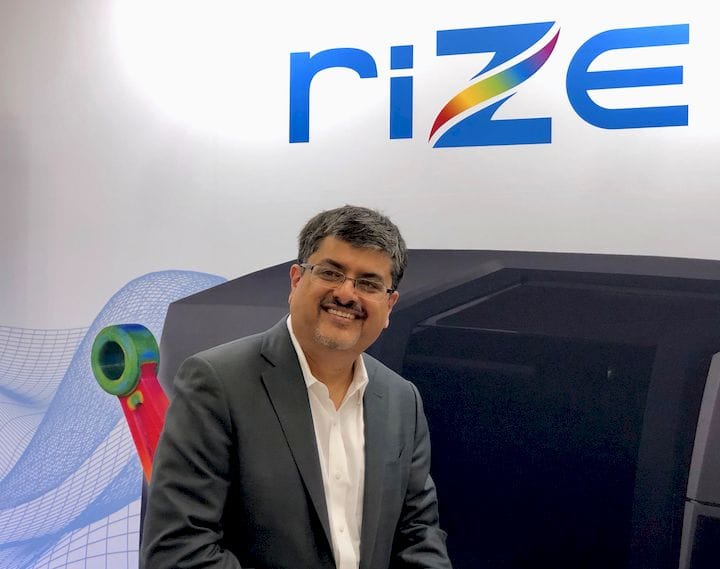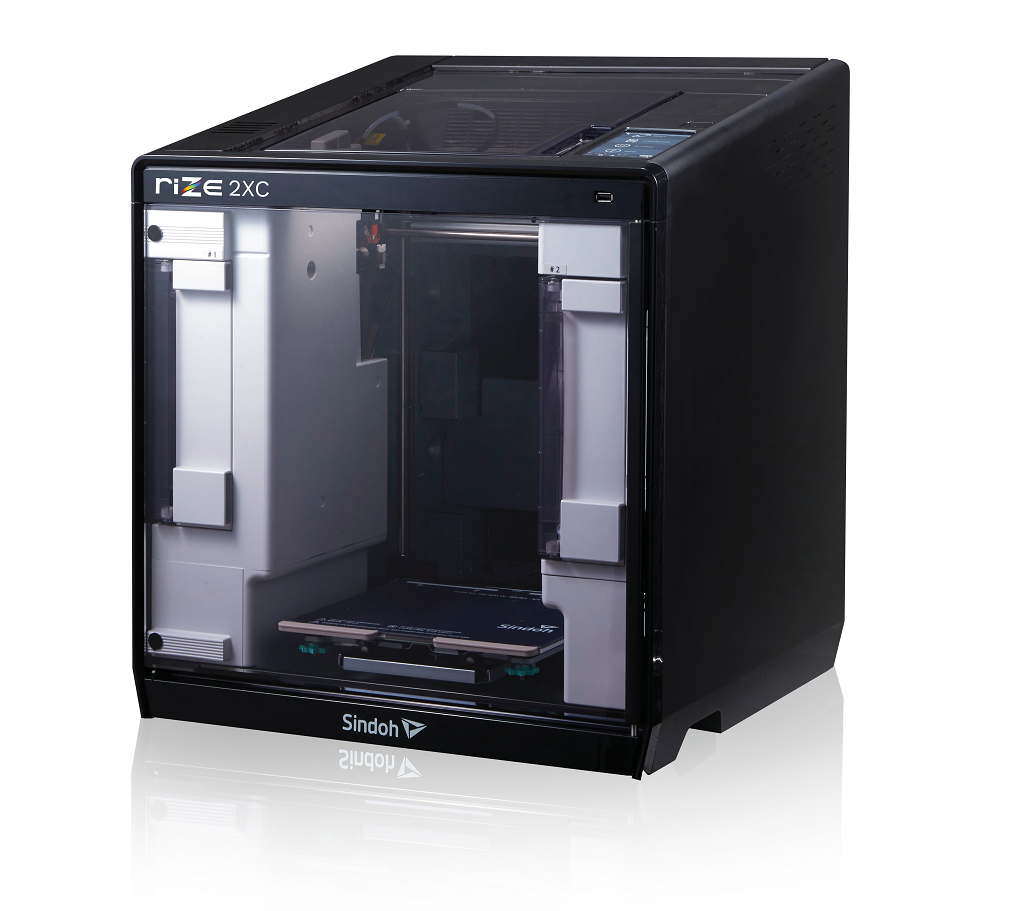
RIZE’s CEO offers some insights into 3D printing safety and a look ahead for 2021.
2020 was a difficult year; while by the end of December such a statement could really go without saying, it’s worth remembering. For the 3D printing industry, 2020 was also a watershed year of opportunity. As the technology came into play for direct and indirect pandemic response, from PPE to supply chain solutions, many companies in this industry actually found significant new opportunities. Beyond sales opportunity, realizable ideas have been shaping up as well for what this new inflection point means for additive manufacturing.
Many of those ideas had already been taking shape at Boston-based RIZE, but there’s a new sparkle in the CEO’s eye as those shapes solidify. I spoke with Andy Kalambi about some recent developments at the company, lasting change brought about by COVID-19, and his thoughts on the bigger picture.
RIZE And Certified 3D Printing Safety
Last week, RIZE announced another milestone: its fifth 3D printing UL GREENGUARD certification.
Kalambi shared his thoughts last year when the company received its first GREENGUARD certification, and he illuminated some interesting implications for 3D printing. When we caught up now, much of the messaging was consistent from that previous conversation. (As a side note, such consistency in company messaging is heartening — and tends to be, in my experience, a hallmark of some of the most successful companies in this industry.)
The latest certification is a major proof point for the newest 3D printer from the company. The RIZE 2XC was introduced earlier this year, the first industrial 3D printer to emerge from the RIZIUM Alliance. Developed with Sindoh and based on existing FFF technology from that company, the idea was to “bring in the safety element” from already-UL-certified RIZE products.

“Look at the industry; there are many price points of operation in the [FFF] world,” Kalambi said. “But let’s look at [FFF] printers as they are; can we move them into this safety paradigm? We worked together with Sindoh, and all the work was done during COVID times.
There was a fair bit of engineering work done. We co-engineered for two things: for composites and then formatting the machine for certification.”
The composites were available upon the 2XC’s introduction, with RIZIUM material-based carbon fiber and glass composite materials. The certification aspect, though, took “a little longer than we expected,” Kalambi noted, due to the high capacity of work labs were experiencing during this unusual year. In more normal times, the certification would have been announced within about a month of the 3D printer, rather than close to half a year. Inevitable delays aside, the certification did happen.
“It’s really the first printer we’ve taken from an existing environment and proven that materials do make the difference. It’s highly driven by materials science and engineering a material to the purpose. And that purpose was really control of VOCs, control of nanoparticles, control of emissions. We introduced a new material for post-processing; we’re obviously not using the jetting process here, because of the [FFF] technology. Again that’s materials science at play, so we’re peeling off supports like on our other printers,” Kalambi said.
That materials science is a huge aspect of what RIZE has been focusing on lately. It’s not a new focus; last year we spoke with the company about the materials basis for their zero-emissions 3D printing, and have continued to follow their bio-friendly strategies. If anything, 2020 and the rise of remote working simply boosted the need for such messaging.
“Everyone is working from home; you see my printer here behind me,” he said, gesturing to the system I saw on camera behind him. “We want people to stay productive. There are people comfortable using their printers working from home, but we want that for industrial people who use industrial printers and usually go to a print lab. In these times of course, this kind of capability lets you do this rapidly. Safe at home, safe anywhere for that matter — how do you make manufacturing safe anywhere?” he asked the big question for production.
Presumably work-from-home as a common practice won’t be forever for those with hands-on jobs. Safety should be of paramount importance in labs as well, of course. While 3D printing at home with professional machines may have accelerated some of the focus on the need for safety, lowering emissions should be an overarching goal for this technology suite.
“All three printers we have are now GREENGUARD certified. We are the only company in the world — and I don’t think it’s for want of trying, but more because the materials science is not there. Hopefully everyone will wake up to this,” Kalambi said. “UL is seen as a standard. You can’t put a 2D printer anywhere without a UL stamp. We want the same for a 3D printer, and hope to see the GREENGUARD certification catching up throughout the industry.”
RIZE In 2020
With that all established, I also had a simple question: how was business in 2020?
Excellent, as it turns out. The market received the RIZE 2XC very well; the first line of production is completely sold already, and the second batch is in progress now. The price point of the system helps, as did offering a holiday sale with surprising international interest:
“We had a Black Friday sale and had orders from the US and overseas. I didn’t know Europe wanted Black Friday sales, but there were orders,” Kalambi laughed.
While the safety message has been “very clear for us,” he continued, “the other message is affordable color, functional color.”
Color 3D printing remains something of a hit-or-miss proposition, generally. Is a color 3D printer a holy grail or a marketing ploy? Critics seem mixed, but ultimately an affordable, reliable, functional full-color 3D print is something the market wants. The medical market in particular can benefit significantly from full-color 3D printing.
“Safe, affordable color for patient-specific medical models — these can be quite expensive,” Kalambi said of one particular application. “There’s a lot of cost associated with taking an MRI and converting it to a printable file, then printing it. The color printing process itself can also be quite expensive. At RIZE, we talk about doing this at 10-20% of the usual cost.”
That affordability could be of major importance for medical usage. Kalambi pointed to a typical full-color 3D printed patient-specific model that might be priced out at $2,200. With RIZE’s color 3D printing capabilities, the material cost for the same model — he held one up for a specific example — would be $80. With 3D printer time, operator time, and the other associated costs added in, that model would be about $200.
It’s not just about medical applications, either. Jigs, tools, and fixtures all use color for ease of identification; design prototyping benefits from full design verification, including the final look.
“We are making color safe, affordable, and mainstream,” Kalambi said simply. “Color has been seen as exotic, especially in the [FFF] world. The concept of color is still restricted. We’ve significantly improved our color fidelity. We want people to think that [FFF] should be in color. If you have a 2D printer, you don’t think about buying only black and white. Most of the time you probably print in black ink, but the times you need it for color, you want that. We believe the same can apply in the 3D printing world.”
RIZE In 2021
RIZE is set to continue on its missions of safety, affordability, and full-color function into the new year.
The company will have more news soon, including some centering on color capabilities. The team is also busy with farther-reaching projects.
RIZE was selected by WEF into the Technology Pioneer 2020 cohort of 100 companies, and is “engaged in a number of initiatives with the WEF.” Much of this centers on future of work initiatives, business models, and how 3D printing can be used in these areas. Further announcements of RIZE’s WEF involvement — and I’m excited about these — will be arising early in the new year.
Kalambi also shared a bit more of a pointed idea about what the big story in 3D printing is; more on that in part two of this interview, to be published shortly.
Via RIZE
